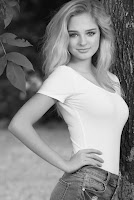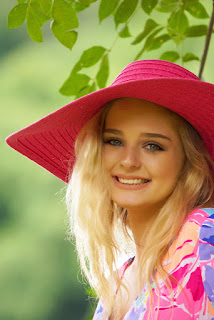Leading up to our shoot the previous few days rain fell and the tempertures dropped lower than are typical for this time of year around these parts. Then the days turned almost perfect when highs in the mid 70's along with a light breeze. Clouds rolled in and created a covering blanket of soft white, which for a photographer is mostly perfect as the sky then becomes a giant softbox casting gently smooth light. Our day was set and the shoot was on...location was Romanza Johnson Park where Trammel Creek winds its way around the edges.
I showed up a little early to set up the changing tent and the speedlight stands...checked and rechecked the settings and the camera remote; Group A channel 1, Group B channel 1...yes, the power settings changed on queue for each. The softbox was attached to Group A light and Group B was powered down to about 1/32nd power...just enough to provide a subtle highlight. Group A is always my main light, and Group B is usually my main highlighter. Sometimes I'll use up to four lights adding a Group C and D all fired as Channel 1, but this day only two lights proved necessary and as it turned out, they worked exactly the way I planned.
 My model was a delightful young lady, Sophie, who arrived shortly there after with her mom. After a quick intro as to what we were wanting to accomplish, we decided to setup along the split rail fence that stretched along the entrance road on the outer edge of the park. Because of the rain, the ground was too muddy elsewhere and the creek was running higher than normal preventing us from using the gravel bar.
My model was a delightful young lady, Sophie, who arrived shortly there after with her mom. After a quick intro as to what we were wanting to accomplish, we decided to setup along the split rail fence that stretched along the entrance road on the outer edge of the park. Because of the rain, the ground was too muddy elsewhere and the creek was running higher than normal preventing us from using the gravel bar.The first few shots I made were simply establishing shots to verify exposure and light angles. Turns out a few of those were pretty good shots and became part of the image grouping. As always my desire was to have the model simply be herself, yet add a hint of sassy along with a dash perky. Some models are more difficult to work with, but some, like Sophie, took to it like a pro. I never overdo instructions, choosing to drop hints and suggestions and then let the model fill in the gaps with her own style and personality. Sometimes it is necessary to encourage a bit more animation from them and then offer a range of opportunity for them to give it a try.
I almost always use a long lens as this allows for a wider range of depth of field control plus it reduces any uncomfortable personal space intrutions that might occur using a shorter focal length lens. Some of the most effective shots are done when you simply allow the model to slowly move across a few yards without posing, without becoming too static. A flip of the hair, a subtle look down, a slight tilt of the head, gentle smile...allow the natural light to work the background, but allow the model to become herself without being overly concerned about her actions. Just allow the off camera flash to fill in the rest of the light.
The key...the eyes. They must be clear, bright, and sharp with strong color definition. Always focus on the eyes, not always an easy compositional task when your model is moving toward you. The trick is to take a lot of shots so you will almost always have a few come out the way you want them to.
Most of my shoots last about an hour and half...move out much past two hours and everyone starts getting tired with a noticable drop off in energy.
 Every photographer develops their own style and I haved gained a great deal of insight from many of my photographer friends. Some tend to slant toward more of an edgy look, others are very creative and stylish, still others are plain and ordinary. Over time my style has grown into a simple homey look accented with a slight amount of sass and sweetness. Mostly I just let the model be themselves as much as possible and encourage them to loosen up enough to feel comfortable with what we are doing.
Every photographer develops their own style and I haved gained a great deal of insight from many of my photographer friends. Some tend to slant toward more of an edgy look, others are very creative and stylish, still others are plain and ordinary. Over time my style has grown into a simple homey look accented with a slight amount of sass and sweetness. Mostly I just let the model be themselves as much as possible and encourage them to loosen up enough to feel comfortable with what we are doing.All in all this early June outing turned out to be a delightful day in the field...and the results...well, I think they turned out rather well.

















